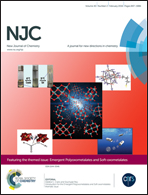Covalently-linked polyoxometalate–polymer hybrids: optimizing synthesis, appealing structures and prospective applications
Abstract
Polyoxometalates (POMs) are a class of polyanions that have fixed metal–oxygen frameworks composed of early transition metals in high oxidation states (most commonly VV, MoVI and WVI). The diversity in composition and configuration endows POMs with fascinating chemical and physical properties, as well as prospective applications in photochromic or electrochromic materials, catalysts, nano-structural materials, medicines and so on. In order to develop more advanced materials based on POMs, a lot of effort has been devoted to the exploration of new types of POMs and combining POMs with other functional units through non-covalent modifications or covalent bonding. Among these delicate studies, integrating inorganic POMs with organic polymers into diverse hybrids through covalent linking is a quite interesting field. We present here a perspective review on the synthesis of POM–polymer hybrids (PPHs) based on covalent modifications, their hierarchical structures and potential applications.

- This article is part of the themed collection: Emergent Polyoxometalates and Soft-oxometalates

 Please wait while we load your content...
Please wait while we load your content...